The Ministry of Construction will submit to the Government the scheme on housing saving fund this April, aiming to start the pilot operation in Hanoi and HCMC late this year or early 2013.
This was informed by Nguyen Manh Ha, head of the Department of Housing and Property Market Management under the construction ministry, at the seminar on comprehensive solutions for the realty market in 2012 held by the Vietnam Real Estate Association and InfoTV in Hanoi on Wednesday.
The scheme consists of two models. The first one will focus on low-income people in need of budget housing and enterprises in search for capital to build low-cost houses, while the second one will target average-income earners.
The housing saving fund will be financed by the existing capital of the housing development fund, contributions of the fund participants, the central budget and 30% of the profits from lottery and housing bond issuance.
The fund’s mobilization rate will be equal to half of the commercial lending rate, possibly at 5% per annum, and the lending rate will be one percentage higher than the deposit rate.
Ha said the fund participants will not make contributions based on their incomes, but mostly on their demand to borrow capital in the future.
Specifically, participants will have to contribute to the fund an amount equivalent to 30% of the money they want to borrow in the future. After 4-5 years, they can access the remaining 70%, and will pay back to the fund in ten years with fixed interest rates.
The housing saving fund was originally planned to follow the model of social insurance, requiring participants to contribute 1% of their monthly incomes to the fund. Such a model is applied in many countries, but the construction ministry deemed it unfeasible in Vietnam because apart from monthly salaries, local laborers also earn from extra jobs and their own businesses.
The fund will offer loans with fixed interest rates despite volatility of the bank lending rates in order to facilitate people to access capital to purchase houses, Ha stressed. - Source: Saigon Times
31 thg 3, 2012
30 thg 3, 2012
Taking a bath in Vietnam real estate
Ho Chi Minh City got a 68-story skyscraper, Vietnam’s tallest, when the downtown Bitexco Financial Tower was inaugurated in 2010. The building, boasting a helipad at the 50th floor, can be seen from almost every part of the city.
It hasn’t been a celebration for the owner, however. Nearly 18 months later half of the building’s office space is still empty and none of the six retail podiums is open. Annualized interest rates reached as high as 23% late last year, and there are plenty of rumors that the owner is trying to sell the building to pay off construction loans. But the company dismisses them. “Bitexco Financial Tower is our pride; we are not selling it,” says Vu Quang Hoi, chairman of Bitexco, a private Vietnamese company that’s invested in more than a dozen other real estate projects, plus infrastructure, energy and mining. “This is a difficult time for businesses, but it is precisely why we need to continue to invest more.”
Not everyone has the same spirit. There are 20 socalled golden sites in the city–prime spots slated for development–but only two projects have been completed and two are under construction; 16 sites are still vacant. Rent for grade-A office space has dropped nearly 50% since 2009. High inflation, high interest rates and the dong’s devaluation have created what CB Richard Ellis Vietnam calls in a January report “a residential nightmare” as property developers boosted their marketing budgets threefold but can sell less than one-third of what they build. Some of the top companies, both private and state-owned enterprises, are also the biggest debtors, and while none of them has declared bankruptcy, it is tough for them to continue investing with the cost of capital so high. There is a saying in Vietnam these days: “It is time to pick up dead bodies on the market.”
But where are the dead bodies? Another joke goes: “There are no distressed assets in Vietnam.” Vietnamese tycoons keep their dire financial situation private, doing deals quietly as people with cash snap up unfinished office buildings, apartment complexes and other projects at rock-bottom prices. For now, though, most such assets are being taken over by banks. Don Lam, chief executive of VinaCapital, a fundmanagement company, says it is working with at least one major bank, going through the list of bad debtors in real estate to revive unfinished projects. If it works, the model, called a “club deal,” will allow new investors to take on the old debt, on the condition that interest rates be fixed for two years.
With more companies struggling, merger and acquisition activity sprouted last year, and more deals are on the way in 2012. The Vietnam Stock Index, which dropped 29% in 2011, is up 31% so far this year, driven by takeover activity.
Meanwhile, the State Bank of Vietnam is forcing more than ten commercial banks to restructure because of liquidity problems caused by a large number of non – performing loans. Dang Van Thanh, the founder of Saigon Commercial Bank, who in 2010 was among the country’s richest people in terms of public shareholdings, is losing control of the bank.
Another high-stakes player, Pham Nhat Vuong, chairman of Vingroup, finds himself sitting on the tiger’s back. His group of companies is investing in at least four major property development projects across the country. But in December it reported a cash flow of only $220 million, which analysts say is not enough to cover liabilities of $1 billion. His Vincom division has had to sell two office towers in Hanoi and Ho Chi Minh City. Now it is hoping to raise between $150 million and $300 million overseas, most likely in Singapore.
Others are seizing oppor – tunities. Masan Group, which has interests in banking, mining and consumer goods, is on a quest to expand. With more than $600 million in cash on hand, it last year acquired 51% of Vinacafe, a maker of instant coffee and other consumer products. - Source: Forbes
It hasn’t been a celebration for the owner, however. Nearly 18 months later half of the building’s office space is still empty and none of the six retail podiums is open. Annualized interest rates reached as high as 23% late last year, and there are plenty of rumors that the owner is trying to sell the building to pay off construction loans. But the company dismisses them. “Bitexco Financial Tower is our pride; we are not selling it,” says Vu Quang Hoi, chairman of Bitexco, a private Vietnamese company that’s invested in more than a dozen other real estate projects, plus infrastructure, energy and mining. “This is a difficult time for businesses, but it is precisely why we need to continue to invest more.”
Not everyone has the same spirit. There are 20 socalled golden sites in the city–prime spots slated for development–but only two projects have been completed and two are under construction; 16 sites are still vacant. Rent for grade-A office space has dropped nearly 50% since 2009. High inflation, high interest rates and the dong’s devaluation have created what CB Richard Ellis Vietnam calls in a January report “a residential nightmare” as property developers boosted their marketing budgets threefold but can sell less than one-third of what they build. Some of the top companies, both private and state-owned enterprises, are also the biggest debtors, and while none of them has declared bankruptcy, it is tough for them to continue investing with the cost of capital so high. There is a saying in Vietnam these days: “It is time to pick up dead bodies on the market.”
But where are the dead bodies? Another joke goes: “There are no distressed assets in Vietnam.” Vietnamese tycoons keep their dire financial situation private, doing deals quietly as people with cash snap up unfinished office buildings, apartment complexes and other projects at rock-bottom prices. For now, though, most such assets are being taken over by banks. Don Lam, chief executive of VinaCapital, a fundmanagement company, says it is working with at least one major bank, going through the list of bad debtors in real estate to revive unfinished projects. If it works, the model, called a “club deal,” will allow new investors to take on the old debt, on the condition that interest rates be fixed for two years.
With more companies struggling, merger and acquisition activity sprouted last year, and more deals are on the way in 2012. The Vietnam Stock Index, which dropped 29% in 2011, is up 31% so far this year, driven by takeover activity.
Meanwhile, the State Bank of Vietnam is forcing more than ten commercial banks to restructure because of liquidity problems caused by a large number of non – performing loans. Dang Van Thanh, the founder of Saigon Commercial Bank, who in 2010 was among the country’s richest people in terms of public shareholdings, is losing control of the bank.
Another high-stakes player, Pham Nhat Vuong, chairman of Vingroup, finds himself sitting on the tiger’s back. His group of companies is investing in at least four major property development projects across the country. But in December it reported a cash flow of only $220 million, which analysts say is not enough to cover liabilities of $1 billion. His Vincom division has had to sell two office towers in Hanoi and Ho Chi Minh City. Now it is hoping to raise between $150 million and $300 million overseas, most likely in Singapore.
Others are seizing oppor – tunities. Masan Group, which has interests in banking, mining and consumer goods, is on a quest to expand. With more than $600 million in cash on hand, it last year acquired 51% of Vinacafe, a maker of instant coffee and other consumer products. - Source: Forbes
Bond index
Chỉ số chứng khoán là một chuỗi số tổng hợp tình hình tăng giảm giá trị của thị trường hàng ngày(*). Trên thế giới có một số chỉ số rất nổi tiếng cho thị trường cổ phiếu như Dow Jones của Mỹ, FTSE của Anh, Nikkei của Nhật, được giới truyền thông đưa tin liên tục. Tuy nhiên hầu như không có một chỉ số trái phiếu nào được biết đến rộng rãi như các chỉ số cổ phiếu. Lý do chủ yếu của sự thiếu vắng này là tính phức tạp của thị trường trái phiếu, các chỉ số trái phiếu thường được chia nhỏ cho các phân nhánh đặc thù của thị trường nên số lượng chỉ số trái phiếu đông đảo và phức tạp hơn chỉ số cổ phiếu rất nhiều.
Hiện tại các chỉ số trái phiếu quốc tế được biết đến nhiều nhất trong giới tài chính đều do các ngân hàng đầu tư tính toán và công bố như các chỉ số trái phiếu của UBS, Barclay (Lehman Brothers), Bank of America (Merrill Lynch), Citigroup (Solomon Smith Barney). Điều này có nguyên nhân từ cấu trúc OTC của thị trường trái phiếu nên thông tin về giá đa số bắt nguồn từ các ngân hàng đầu tư lớn là các nhà tạo lập thị trường cho trái phiếu. Dạng chỉ số này gọi là chỉ số giá giao dịch (transaction price index).
Chỉ số giá giao dịch có một nhược điểm lớn là nhiều loại trái phiếu có thanh khoản rất thấp nên một vài giao dịch lớn có thể làm giá thay đổi rất mạnh. Ngoài ra có những trái phiếu không được giao dịch thường xuyên nên có những ngày không có giá giao dịch để tính chỉ số. Để giải quyết vấn đề này người ta đưa ra hai loại chỉ số khác là chỉ số giá ma trận (matrix price index) và chỉ số giá chào (dealer price index). Loại đầu sử dụng một vài mô hình định giá trái phiếu để ước lượng giá cho những trái phiếu có thanh khoản thấp. Loại thứ hai tính trung bình giá chào mua và chào bán của các nhà tạo lập thị trường (dealer) để xây dựng chỉ số.
Bên cạnh việc phân loại chỉ số trái phiếu theo nguồn số liệu, người ta thường chia theo loại hình trái phiếu, ví dụ trái phiếu chính phủ và doanh nghiệp, trái phiếu không trả lãi suất định kỳ, trái phiếu hiệu chỉnh lạm phát, trái phiếu với thời gian đáo hạn nằm trong một khoảng nhất định. Một cách phân loại phổ biến khác là theo rủi ro tín dụng, ví dụ trái phiếu hạng đầu tư (invesment grade) cho những trái phiếu có rủi ro tín dụng cao hơn mức BBB(#) và trái phiếu lợi suất cao (high yield hay junk) cho những loại được đánh giá thấp hơn. Thông thường với bất kỳ chuỗi chỉ số trái phiếu nào cũng được tính với giá sạch (clean price index) và với giá toàn phần (total return index). Các chỉ số giá toàn phần khác nhau sẽ có các giả thiết tái đầu tư tiền lãi định kỳ khác nhau.
(Ghi chú:
(*) Hiện tại nhiều chỉ số chứng khoán được tính theo thời gian thực (real time).
(#) Ranh giới giữa trái phiếu hạng đầu tư và trái phiếu lợi tức cao không cố định, phụ thuộc vào cách phân loại của từng công ty tính toán chỉ số.)
29 thg 3, 2012
Housing saving fund project to be submitted to the government in April
Ministry of Construction will submit the project of housing saving fund to the government in April and start the pilot operation of the fund in Hanoi and HCM City by the end of 2012 or 2013.
The information was shared at the seminar in Hanoi on March 28 about general solutions for the property market in 2012 by Mr Nguyen Manh Ha, Head of Housing and Real Estate Market Management Department (under Ministry of Construction).
The project includes two modes. In the first mode, the Housing Saving and Development Fund enables low-income earners to borrow loans to buy houses and social houses, or supports enterprises to build low-cost housing and social housing plans. In the second mode, the fund will help those with stable income from medium and higher levels purchase houses.
Under it, the housing saving fund will be formed from the available capital of Housing Development Fund, savings of those demanding to join the fund, Central Funds, 30% profit from issuing state lottery and housing bonds. Capital mobilization interest rate for the fund will be equal to a half of commercial loan rate (estimated at 5% per annum); lending rate will be equivalent with deposit rate of the fund plus 1%.
Mr Ha explained that people will contribute capital to the saving fund on the basis of capital borrowing demand in future instead salary.
For example, if borrowing 500 million dong to buy a 50-square meter house, a person will have to pay 30% of total sum of money. After 4-5 years, they will be able to borrow another 70% of remaining sum and the loan will be paid within 10 years with fixed interest rate. - Source: Vietbiz24
The information was shared at the seminar in Hanoi on March 28 about general solutions for the property market in 2012 by Mr Nguyen Manh Ha, Head of Housing and Real Estate Market Management Department (under Ministry of Construction).
The project includes two modes. In the first mode, the Housing Saving and Development Fund enables low-income earners to borrow loans to buy houses and social houses, or supports enterprises to build low-cost housing and social housing plans. In the second mode, the fund will help those with stable income from medium and higher levels purchase houses.
Under it, the housing saving fund will be formed from the available capital of Housing Development Fund, savings of those demanding to join the fund, Central Funds, 30% profit from issuing state lottery and housing bonds. Capital mobilization interest rate for the fund will be equal to a half of commercial loan rate (estimated at 5% per annum); lending rate will be equivalent with deposit rate of the fund plus 1%.
Mr Ha explained that people will contribute capital to the saving fund on the basis of capital borrowing demand in future instead salary.
For example, if borrowing 500 million dong to buy a 50-square meter house, a person will have to pay 30% of total sum of money. After 4-5 years, they will be able to borrow another 70% of remaining sum and the loan will be paid within 10 years with fixed interest rate. - Source: Vietbiz24
Difficulties force property investors to change
The troubled property market is forcing investors to be more efficient - by restructuring investment, transferring projects, or simply leaving.
In the heyday of the property market several years ago, numerous enterprises active in other sectors sought to make their way into the market and develop apartment projects.
Hoa Sen Group for instance aimed to move beyond its five major business fields - steel, building materials, financial investment, seaports and logistics - by investing in the realty sector.
The Pho Dong-Hoa Sen Building project in HCM City's District 9 kicked off in late 2009 was the group's first step to step into the property market.
It was one of the three projects Hoa Sen planned to develop in District 9, with 200 apartments expected to be launched into the market.
However, after two years of deployment, the group decided to transfer its 50 percent stake to its partner Pho Dong Development Investment Joint Stock Co.
The unfavourable property market has also forced the group to halt other projects.
Particularly, Hoa Sen Group is seeking partners to transfer the apartment projects Hoa Sen Phuoc Long B and Hoa Sen Riverview, both in District 9, together with a land plot along Tran Nao Street in District 2.
Macro-economic upheavals, coupled with the slump in the realty market, spark a need for Hoa Sen to sell property projects to focus on its core businesses.
According to Chair Le Phuoc Vu of Hoa Sen Group said the group would not make dispersed investment anymore.
Similarly, the Vietnam National Oil and Gas Group (PetroVietnam) will pull out of the complex project consisting of a five-star hotel, a commercial centre, a theme park, and a petroleum tower in Tu Liem District, Hanoi, upon the prime minister's request last week.
The project is taken over by PetroVietnam Construction Joint Stock Corporation (PVC).
While outside investors are divesting their capital in the property sector, insiders are striving to transfer their projects and land.
Van Phat Hung Corporation said it would liquidate the land plots in District 2 and 9 in HCM City, and offer the land for the company's office in District 7.
Besides the target to sell 70 apartments of the Lacasa project within this year, the real estate company will issue 300 billion dong worth of convertible bonds in order to have more working capital for the its plans in short and medium terms.
Likewise, Pacific Property and Infrastructure Development Joint Stock Co. (PPI) is looking for investors to cooperate or transfer two projects in Thu Duc District, HCM City.
The company is offering the 2,400-square-metre land plot of the PPI Tower office and apartment building in Hiep Binh Chanh Ward at 29 million dong per square metre, as well as seeking partners for the Water Garden complex project also in Hiep Binh Chanh.
The two-hectare land site for the project development is being offered at 15 million dong a square metre.
2012 is considered the year of mergers and acquisitions (M&A) activity with many opportunities for the financially-capable investors.
Phan Xuan Can, chair of the property service provider Soho Vietnam, said the demand for realty project transfer was now higher than ever.
The service provider has been asked by other developers to offer 80 projects of several segments from apartments, office land, and urban areas to resorts.
The rising number of projects offered for changing hands is ascribed to tightening monetary policy, high banking interest rates, and the weak liquidity of the market.
Can said that the property market was undergoing thorough selection and only financially- capable and experienced investors would be able to survive.
"The market is restructuring itself and in the next 2-3 years, the Vietnam property market will have a new face," he said. - Source: Vietbi24
In the heyday of the property market several years ago, numerous enterprises active in other sectors sought to make their way into the market and develop apartment projects.
Hoa Sen Group for instance aimed to move beyond its five major business fields - steel, building materials, financial investment, seaports and logistics - by investing in the realty sector.
The Pho Dong-Hoa Sen Building project in HCM City's District 9 kicked off in late 2009 was the group's first step to step into the property market.
It was one of the three projects Hoa Sen planned to develop in District 9, with 200 apartments expected to be launched into the market.
However, after two years of deployment, the group decided to transfer its 50 percent stake to its partner Pho Dong Development Investment Joint Stock Co.
The unfavourable property market has also forced the group to halt other projects.
Particularly, Hoa Sen Group is seeking partners to transfer the apartment projects Hoa Sen Phuoc Long B and Hoa Sen Riverview, both in District 9, together with a land plot along Tran Nao Street in District 2.
Macro-economic upheavals, coupled with the slump in the realty market, spark a need for Hoa Sen to sell property projects to focus on its core businesses.
According to Chair Le Phuoc Vu of Hoa Sen Group said the group would not make dispersed investment anymore.
Similarly, the Vietnam National Oil and Gas Group (PetroVietnam) will pull out of the complex project consisting of a five-star hotel, a commercial centre, a theme park, and a petroleum tower in Tu Liem District, Hanoi, upon the prime minister's request last week.
The project is taken over by PetroVietnam Construction Joint Stock Corporation (PVC).
While outside investors are divesting their capital in the property sector, insiders are striving to transfer their projects and land.
Van Phat Hung Corporation said it would liquidate the land plots in District 2 and 9 in HCM City, and offer the land for the company's office in District 7.
Besides the target to sell 70 apartments of the Lacasa project within this year, the real estate company will issue 300 billion dong worth of convertible bonds in order to have more working capital for the its plans in short and medium terms.
Likewise, Pacific Property and Infrastructure Development Joint Stock Co. (PPI) is looking for investors to cooperate or transfer two projects in Thu Duc District, HCM City.
The company is offering the 2,400-square-metre land plot of the PPI Tower office and apartment building in Hiep Binh Chanh Ward at 29 million dong per square metre, as well as seeking partners for the Water Garden complex project also in Hiep Binh Chanh.
The two-hectare land site for the project development is being offered at 15 million dong a square metre.
2012 is considered the year of mergers and acquisitions (M&A) activity with many opportunities for the financially-capable investors.
Phan Xuan Can, chair of the property service provider Soho Vietnam, said the demand for realty project transfer was now higher than ever.
The service provider has been asked by other developers to offer 80 projects of several segments from apartments, office land, and urban areas to resorts.
The rising number of projects offered for changing hands is ascribed to tightening monetary policy, high banking interest rates, and the weak liquidity of the market.
Can said that the property market was undergoing thorough selection and only financially- capable and experienced investors would be able to survive.
"The market is restructuring itself and in the next 2-3 years, the Vietnam property market will have a new face," he said. - Source: Vietbi24
Tougher management on public land and property needed

The wasteful use of land is popular across the country, especially in big cities but local authorities can not take back these wasted land areas for more profitable purposes as current regulations state that land owned by state-owned enterprises is subject to central agencies’ management.
According to the State Property Management Bureau, State enterprises alone are now managing a total land area of 155 million square meters. Although many of them do not have enough capital to restructure their business, they refuse to sell or put their land into good use.
Over the past time, many localities have dispatched delegations to grass-roots levels to review land use, detecting that lots of land lots are not in use or leased by other organizations without paying taxes.
To generate cash from public land and property use for socio-economic development, the Government approved long-term land planning schemes proposed by localities.
Accordingly, localities are allowed to take back land lots that are used inefficiently and wastefully by central agencies to build new social welfare works or facilities of beneficial purposes.
In its recent move, the Ministry of Finance is now finalizing a project on exploiting financial resources from public land and property use for socio-economic development in a bid to have tougher measures against the wasteful use of public land and property. - Source: baomoi
Indenture and covenant
Giao kèo (indenture) của trái phiếu là một văn bản gắn liền với mỗi loại trái phiếu được phát hành. Văn bản này đưa ra những cam kết, ràng buộc, nghĩa vụ và quyền lợi của nhà phát hành và nhà đầu tư. Về mặt pháp lý nó tương đương như một hợp đồng thương mại giữa nhà phát hành và nhà đầu tư, thường được giao cho một bên thứ ba (trustee) đứng ra giám sát. Giao kèo trái phiếu qui định những thông tin chính yếu liên quan đến trái phiếu được phát hành như tổng khối lượng, lãi suất định kỳ (coupon rate), thời hạn (maturity), kế hoạch trả lãi/vốn, mức độ rủi ro tín dụng (credit rating), tài sản thế chấp nếu có, thứ tự ưu tiên thanh toán nếu doanh nghiệp phát hành phá sản (seniority), khả năng thu hồi (callable) hay khả năng hoàn trả (putable). Trong vụ Hi lạp vỡ nợ vừa rồi, một điều khoản được báo chí nhắc rất nhiều là ứng xử tương đồng (collective action clause), trong đó qui định nếu 90%(*) nhà đầu tư đồng ý với một phương án giải quyết nợ nào đó thì những nhà đầu tư còn lại bắt buộc phải tuân theo.
Một phần rất quan trọng trong mỗi bản giao kèo trái phiếu là các giao ước (covenant) của nhà phát hành. Giao ước trái phiếu thường được phân làm hai nhóm, giao ước buộc phải làm (positive covenant) và giao ước không được phép làm (negative covenant). Ví dụ của nhóm giao ước thứ nhất là giao ước trả lãi suất định kỳ đúng hạn, giao ước thực hiện đúng kế hoạch kinh doanh, đầu tư đề ra trong bản cáo bạch (prospectus). Nhóm giao ước không được làm thường quan trọng hơn và chi tiết hơn. Ví dụ giao ước không được bán hoặc thanh lý một số tài sản cố định, không được để tỷ lệ tài sản có thanh khoản cao (liquid asset) thấp hơn một mức cho trước, giao ước không được vay hoặc phát hành thêm trái phiếu vượt quá giới hạn nhất định, giao ước không vi phạm các giao kèo trái phiếu khác (cross default clause - pari passu clause).
Văn bản giao kèo và giao ước trái phiếu thường được giới luật sư chuyên nghiệp và ngân hàng đầu tư soạn thảo. Trong thời gian gần đây một số tổ chức phi chính phủ như Bond Covenanant Group của Anh hay The Credit Roundtable của Mỹ đang cố gẳng chuẩn hóa một số điều khoản quan trọng trong các bản giao kèo/giao ước trái phiếu để giúp nhà đầu tư đánh giá rủi ro và định giá trái phiếu dễ dàng hơn.
(Ghi chú: (*) Tỷ lệ này có thể thay đổi tùy theo từng loại trái phiếu.)
Vincom raises USD185 million in CB offering
VNRE - Vincom Joint Stock Company, Vietnam’s largest real estate company, has returned to the international convertible bond market less than three years after its landmark debut convertible bond (CB) in 2009, raising US$185 million.
This is Vincom’s second convertible bond issue since its US$100 million debut CB offering in November 2009, which was also the first ever offshore CB issued by a Vietnamese corporate.
The latest transaction was launched with a base issue size of US$150 million with an upsize option of US$100 million, part of which was exercised at the time of pricing. The remaining US$65 million upsize can be exercisable within 30 days after the deal’s closing date on April 2012.
The US dollar-denominated bonds carry a coupon of 5 percent and are convertible into the ordinary shares of Vincom at a conversion price of 112,200 dong (USD5.4), which represents a premium of 10 percent over the stock close of 102,000 dong on March 28.
The CB, which matures in 2017, comes with an investor put option at year two, giving investors a choice to sell the bonds back to the issuer in April 2014. The transaction features annual conversion price reset on October 3 each year until 2016. The conversion price cannot be adjusted to less than 80% of the initial conversion price.
The company plans to use the net proceeds to finance investment in property developments, working capital and general corporate purposes.
The CB provides the company with long-term financing at attractive terms and diversifies its sources of funding, the company noted in a statement.
“We are encouraged by the strong interest for [the transaction], which emphasises the attractiveness of Vincom and Vietnam’s real estate sector,” Mai Huong Noi, Vincom’s general director said in the statement. “The interest rate of 5 percent is attractive for such unsecured CBs. Vincom has been a leader for Vietnamese companies to access international markets, and we hope this transaction will enable other companies to follow suit.”
The company held site visits in early March in Hanoi for potential investors and went to roadshows in Hong Kong and Singapore where it met over 30 investors in one-on-one and group meetings before pricing the transaction on March 28.
Credit Suisse, which was the sole bookrunner for the Vincom’s debut CB offering, was again the sole bookrunner in the current transaction. The bonds will be listed on the Singapore Exchange.
Vincom, with a market capitalization of approximately US2.56 billion, is the largest listed real estate company in Veitnam by market cap. The company develops, leases out and sells retail, office, residential, resort and mixed-use properties in major cities in Vietnam.
Reported by Gita Dhungana | The Asset
Sovico Shopping Center
VNRE - Address: Quang Trung Street, Hai Ba Trung District, Hanoi
- Category: Resident and Commercial Centre Building
- Scale of project (GFA): 41,597.1m2 (excluding basement)
- Architecture Design: HighEnd Architecture
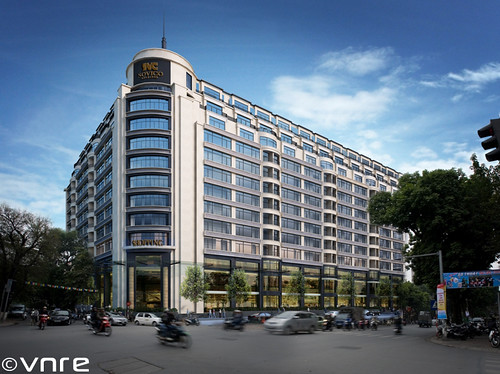
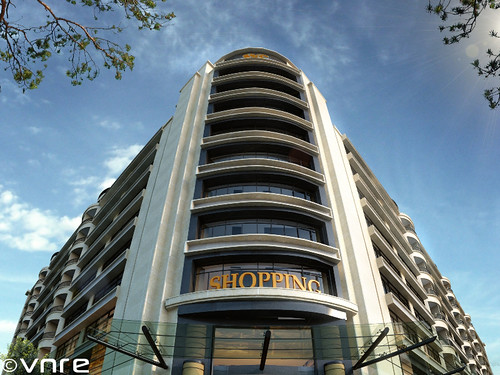
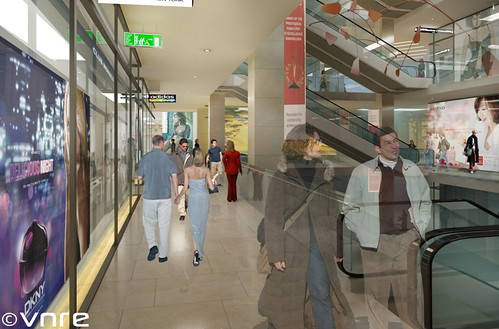
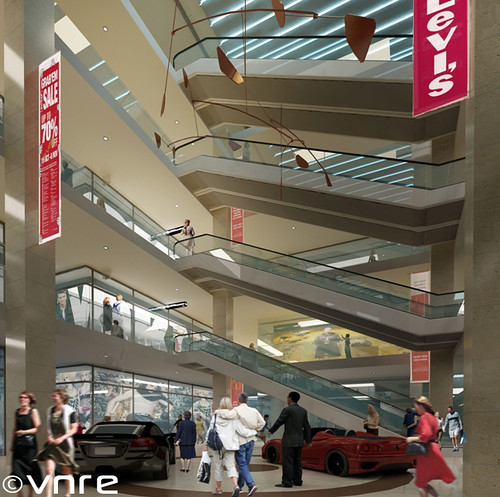

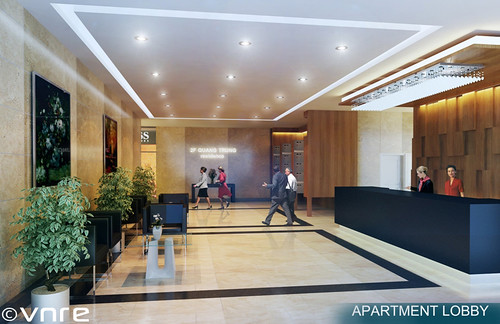

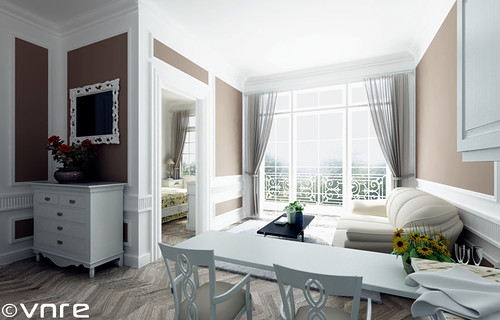
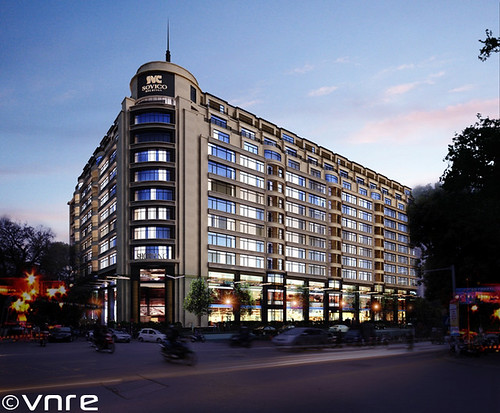
Source: HighEnd Architecture
- Category: Resident and Commercial Centre Building
- Scale of project (GFA): 41,597.1m2 (excluding basement)
- Architecture Design: HighEnd Architecture









Source: HighEnd Architecture
Nhãn:
Renders
Google Account Video Purchases
Hà Nội, Hoàn Kiếm, Hà Nội, Việt Nam
Dalat Novotel Hotel
VNRE - Address: Anh Sang Park, Ward 1, DaLat City.
- Category: 4-star hotel
- Scale of project (GFA): 16.141 m2; 170 rooms
- Architecture Design: HighEnd Architecture



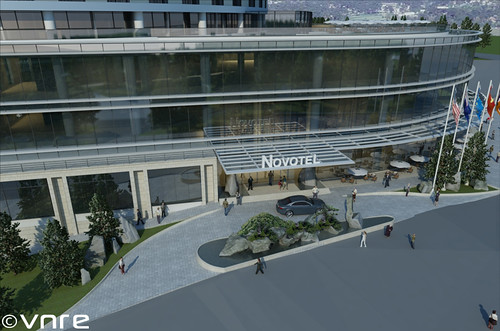
Source: HighEnd Architecture
- Category: 4-star hotel
- Scale of project (GFA): 16.141 m2; 170 rooms
- Architecture Design: HighEnd Architecture




Source: HighEnd Architecture
Nhãn:
Renders
Google Account Video Purchases
Nguyễn Văn Cừ, Phường 1, Đà Lạt, Lâm Đồng, Việt Nam
28 thg 3, 2012
Low-cost apartment projects find buyers
Eden Real Company reported homebuyers showed interest in apartment units worth below 1.5 billion dong each at a week-long property fair in HCM City last week with some 1,000 visitors.
There were 40 successful transactions during the six-day fair, mainly in Tan Phu District’s Quang Thai and Chuong Duong projects and District 7’s Ngoc Lan apartments, said Huynh Kim Doan, director of Eden Real.
Installment payments, which enable customers to make a down payment equivalent to half of the apartment’s value and the rest will be paid within two years, is a factor appealing to homebuyers alongside affordable prices of apartments.
Doan said her company did not anticipate a high sales target in this event in current unfavorable conditions of the real estate market. However, what it obtained exceeded her expectations.
Along with individual clients, the company got wholesale orders for some projects in HCM City. There were also about 200 homebuyers looking for townhouses. - Source: Saigon Times
There were 40 successful transactions during the six-day fair, mainly in Tan Phu District’s Quang Thai and Chuong Duong projects and District 7’s Ngoc Lan apartments, said Huynh Kim Doan, director of Eden Real.
Installment payments, which enable customers to make a down payment equivalent to half of the apartment’s value and the rest will be paid within two years, is a factor appealing to homebuyers alongside affordable prices of apartments.
Doan said her company did not anticipate a high sales target in this event in current unfavorable conditions of the real estate market. However, what it obtained exceeded her expectations.
Along with individual clients, the company got wholesale orders for some projects in HCM City. There were also about 200 homebuyers looking for townhouses. - Source: Saigon Times
FDI inflow to real estate back on top
The foreign direct investment (FDI) inflow to the local property sector has regained the leading position in terms of fresh capital in the first quarter of 2012, after a long period of sharp decline due to the market woes.
Real estate accounted for 45.5% of the total registered capital in the year’s first three months, said the Foreign Investment Agency (FIA) under the Ministry of Planning and Investment. This achievement is partially attributed to the US$1.2-billion Tokyu Binh Duong Garden City project developed by Becamex IDC and Japan’s Tokyu Corporation.
However, this does not mean the local property market is prospering.
The investor of the aforesaid project is aiming at the long-term target of the Binh Duong New City project. Therefore, the joint venture kicked off the project right on the day they received the investment certificate in early this March so as to promptly complete the 71-hectare project before Binh Duong becomes a centrally-governed city in 2020.
The billion-dollar Tokyu Binh Duong Garden City project helps take the total newly registered and additional FDI capital in the first three months of the year to some US$2.63 billion, equal to 63.6% of the same period last year.
As of March 20, there have been 120 fresh projects licensed nationwide worth US$2.26 billion, or 77.2% of the year-ago period. In the mean time, 29 operational projects registered to raise their investment capital by an additional US$368 million, 30.4% of the same period in 2011, said FIA.
Manufacturing and processing industries, which topped the list in the first two months, fall to the second place with 51 newly registered projects and 25 projects adjusting up capital worth US$1.17 billion in total, accounting for 44.6% of the total registered capital.
Transport and storage take the third position with US$180 million in fresh and additional FDI capital, or 6.8% of the total registered capital in the first quarter.
According to FIA, in the last three months, the foreign capital inflows to the big projects were mostly sourced from Japanese investors. Specifically, apart from the US$1.2-billion property project mentioned above, there are also a project worth US$574 million invested by the Japanese tire maker Bridgestone Corporation in the Haiphong-based Dinh Vu Industrial Park and the US$180-million project of Oshima Shipbuilding Co. Ltd.
With many large-scale projects, Japan has become the biggest foreign investor in Vietnam in the first quarter, with the newly registered and additional capital reaching US$2.3 billion, equivalent to 88.8% of the nation’s total.
The Netherlands ranks second with US$46.1 million, or 1.7%, followed by Taiwan with US$42.9 million, 1.6%.
FDI disbursement in the first quarter of the year also shows positive signs, said FIA. Particularly, FDI enterprises disbursed some US$1.52 billion in March, taking the total disbursement of the first three months to US$2.52 billion, or 99.2% of the year-ago period. - Source: Saigon Times
Real estate accounted for 45.5% of the total registered capital in the year’s first three months, said the Foreign Investment Agency (FIA) under the Ministry of Planning and Investment. This achievement is partially attributed to the US$1.2-billion Tokyu Binh Duong Garden City project developed by Becamex IDC and Japan’s Tokyu Corporation.
However, this does not mean the local property market is prospering.
The investor of the aforesaid project is aiming at the long-term target of the Binh Duong New City project. Therefore, the joint venture kicked off the project right on the day they received the investment certificate in early this March so as to promptly complete the 71-hectare project before Binh Duong becomes a centrally-governed city in 2020.
The billion-dollar Tokyu Binh Duong Garden City project helps take the total newly registered and additional FDI capital in the first three months of the year to some US$2.63 billion, equal to 63.6% of the same period last year.
As of March 20, there have been 120 fresh projects licensed nationwide worth US$2.26 billion, or 77.2% of the year-ago period. In the mean time, 29 operational projects registered to raise their investment capital by an additional US$368 million, 30.4% of the same period in 2011, said FIA.
Manufacturing and processing industries, which topped the list in the first two months, fall to the second place with 51 newly registered projects and 25 projects adjusting up capital worth US$1.17 billion in total, accounting for 44.6% of the total registered capital.
Transport and storage take the third position with US$180 million in fresh and additional FDI capital, or 6.8% of the total registered capital in the first quarter.
According to FIA, in the last three months, the foreign capital inflows to the big projects were mostly sourced from Japanese investors. Specifically, apart from the US$1.2-billion property project mentioned above, there are also a project worth US$574 million invested by the Japanese tire maker Bridgestone Corporation in the Haiphong-based Dinh Vu Industrial Park and the US$180-million project of Oshima Shipbuilding Co. Ltd.
With many large-scale projects, Japan has become the biggest foreign investor in Vietnam in the first quarter, with the newly registered and additional capital reaching US$2.3 billion, equivalent to 88.8% of the nation’s total.
The Netherlands ranks second with US$46.1 million, or 1.7%, followed by Taiwan with US$42.9 million, 1.6%.
FDI disbursement in the first quarter of the year also shows positive signs, said FIA. Particularly, FDI enterprises disbursed some US$1.52 billion in March, taking the total disbursement of the first three months to US$2.52 billion, or 99.2% of the year-ago period. - Source: Saigon Times
3 Things To Avoid When You Give Your Next Speech
If you don't want to get your speech off to a bad start, the communications experts at Speechworks suggest you:
- Don't apologize (particularly about your anxiety or lack of preparation. Apologies put your audience on the defensive.
- Don't start by telling a joke (which may not be all that funny, or is irrelevant, or that may even be offensive to someone in your audience).
- Don't beat around the bush (including, don't list off a lot of people you want to thank. Don't waste your audience's valuable time)
- If you need to deal with your anxiety, practice like crazy. Rehearse particularly your first line over and over.
- Start your presentation by laying out for your audience a key issue that they are facing in their business.
- If you must thank someone, do it at the end, or thank your introducer briefly, pause, and then start right into the meat of your message.
Taking a Bath in Vietnam Real Estate
VNRE - Ho Chi Minh City got a 68-story skyscraper, Vietnam’s tallest, when the downtown Bitexco Financial Tower was inaugurated in 2010. The building, boasting a helipad at the 50th floor, can be seen from almost every part of the city.
It hasn’t been a celebration for the owner, however. Nearly 18 months later half of the building’s office space is still empty and none of the six retail podiums is open. Annualized interest rates reached as high as 23% late last year, and there are plenty of rumors that the owner is trying to sell the building to pay off construction loans. But the company dismisses them. “Bitexco Financial Tower is our pride; we are not selling it,” says Vu Quang Hoi, chairman of Bitexco, a private Vietnamese company that’s invested in more than a dozen other real estate projects, plus infrastructure, energy and mining. “This is a difficult time for businesses, but it is precisely why we need to continue to invest more.”
Not everyone has the same spirit. There are 20 socalled golden sites in the city--prime spots slated for development--but only two projects have been completed and two are under construction; 16 sites are still vacant. Rent for grade-A office space has dropped nearly 50% since 2009. High inflation, high interest rates and the dong’s devaluation have created what CB Richard Ellis Vietnam calls in a January report “a residential nightmare” as property developers boosted their marketing budgets threefold but can sell less than one-third of what they build. Some of the top companies, both private and state-owned enterprises, are also the biggest debtors, and while none of them has declared bankruptcy, it is tough for them to continue investing with the cost of capital so high. There is a saying in Vietnam these days: “It is time to pick up dead bodies on the market.”
But where are the dead bodies? Another joke goes: “There are no distressed assets in Vietnam.” Vietnamese tycoons keep their dire financial situation private, doing deals quietly as people with cash snap up unfinished office buildings, apartment complexes and other projects at rock-bottom prices. For now, though, most such assets are being taken over by banks. Don Lam, chief executive of VinaCapital, a fundmanagement company, says it is working with at least one major bank, going through the list of bad debtors in real estate to revive unfinished projects. If it works, the model, called a “club deal,” will allow new investors to take on the old debt, on the condition that interest rates be fixed for two years.
With more companies struggling, merger and acquisition activity sprouted last year, and more deals are on the way in 2012. The Vietnam Stock Index, which dropped 29% in 2011, is up 31% so far this year, driven by takeover activity.
Meanwhile, the State Bank of Vietnam is forcing more than ten commercial banks to restructure because of liquidity problems caused by a large number of non - performing loans. Dang Van Thanh, the founder of Saigon Commercial Bank, who in 2010 was among the country’s richest people in terms of public shareholdings, is losing control of the bank.
Another high-stakes player, Pham Nhat Vuong, chairman of Vingroup, finds himself sitting on the tiger’s back. His group of companies is investing in at least four major property development projects across the country. But in December it reported a cash flow of only $220 million, which analysts say is not enough to cover liabilities of $1 billion. His Vincom division has had to sell two office towers in Hanoi and Ho Chi Minh City. Now it is hoping to raise between $150 million and $300 million overseas, most likely in Singapore.
Others are seizing oppor - tunities. Masan Group, which has interests in banking, mining and consumer goods, is on a quest to expand. With more than $600 million in cash on hand, it last year acquired 51% of Vinacafe, a maker of instant coffee and other consumer products.
Reported by Lan Anh Nguyen
Photo: Hoang Dinh Nam / AFP / Getty Images
Source: Forbes
Benchmark yield curve
Trên thực tế thị trường trái phiếu quốc tế có hai khái niệm đường cong lợi suất chuẩn. Khái niệm thứ nhất là đường cong lợi suất tham chiếu (benchmark yield curve) của trái phiếu chính phủ mới phát hành (on-the-run). Đây là đường cong lợi suất mà giới truyền thông và các dịch vụ thông tin tài chính thường nhắc đến nhưng chỉ nó có giá trị giao dịch cho một số ít trái phiếu chính phủ cấu thành đường cong đó và làm tham chiếu cho các loại bond khác. Khái niệm thứ hai ít được báo chí biết đến, thường được giới học thuật gọi là đường cong lợi suất của trái phiếu không có lãi suất định kỳ (zero-coupon yield curve hay ngắn gọn hơn là zero-curve) còn giới tài chính thường gọi là đường cong lợi suất giao ngay (spot curve). Đây mới chính là đường cong lợi suất chuẩn mà giới chuyên gia tài chính dùng để định giá tất cả các loại trái phiếu giao dịch trên thị trường.
Khái niệm đường cong lợi suất thứ nhất chỉ đơn giản là tập hợp lợi suất của các loại trái phiếu chính phủ vừa được phát hành (on-the-run) có thời hạn khác nhau. Khái niệm thứ hai phải được ước lượng từ một số lượng lớn trái phiếu chính phủ đang được giao dịch trên thị trường. Với các phương pháp ước lượng khác nhau người ta có thể có các đường cong lợi suất chuẩn (spot curve) khác nhau. Trên thị trường phổ biến nhất là ước lượng của các ngân hàng trung ương, các hãng cung cấp thông tin tài chính lớn như Bloomberg và Reuters, và một số ngân hàng đầu tư quốc tế như Barclays, UBS, ICAP.
Về mặt lý thuyết có hai phương án ước lượng cơ bản là phương pháp có thông số (parametric) và ước lượng không thông số (non-parametric). Cách thứ nhất, điển hình là phương pháp Nelson-Siegel sử dụng một mô hình lý thuyết tối giản toàn bộ đường cong lợi suất thành một công thức với vài thông số cơ bản. Số liệu giá giao dịch của các loại trái phiếu được sử dụng để ước lượng các thông số đó. Cách thứ hai sử dụng một vài kỹ thuật làm trơn (smoothing) để ước lượng giá trị trung bình cho từng điểm trên đường cong lợi suất, ví dụ kỹ thuật spline fitting. Nhìn chung các kỹ thuật ước lượng không quá phức tạp, cái khó nằm ở chỗ phải có một lượng đủ lớn dữ liệu giá giao dịch trái phiếu. Điều này đòi hỏi phải có một thị trường thứ cấp có thanh khoản tốt.
When To Coach And When To Counsel
A good manager is both a coach and a counselor. Generally, coaching should precede counseling.
As a coach, a manager:
- identifies an employee's need for instruction and direction
You coach to help retain employees and to show you care about your employees as individuals. It's best to coach when a new procedure is introduced, a job is changed, and/or a skill gap is identified.
As a counselor, a manager:
- first identifies a problem that interferes with an employee's work performance and then helps the employee to define specifically what behavior he or she needs to change in order to improve his or her performance or resolve a problem.
- Motivates employees to do good work
- Reinforces good performance
- Encourages employees to stretch
- Sets clear expectations
- Provides positive feedback on an ongoing basis
- Provides constructive feedback on a timely basis
- Acknowledges employees' progress toward their goals
StarCity Nha Trang - An original choice satisfying dreams
VNRE - Condotel model (hotel renting management) began in South Florida in the 80s and now expands all over the world and valuated as “hottest trend” on real estate market. Condotel is tourism real estate model or the ‘second home’ for high class relaxing demand. To own the Condotel is the choice of not only noble but also successful people.
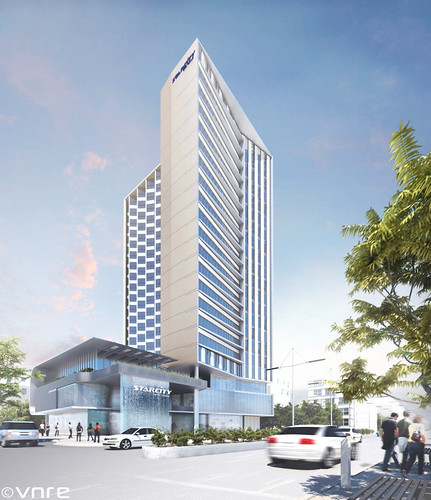
Owning the most beautiful location in Nha Trang at the centre of Tran phu street and opposite to the sea, StarCity Nha Trang is a special gift for sea lovers who want to dip their lives into fresh nature. From the hotel, the condotel owners could easily access to famous spot such as Ponagar temple, Yanbay cascade, Long Son pagoda…
StarCity Nha Trang is a 21 storey – 4 star hotel built on area of 2.454 m2 with 217 hotel rooms and 92 condotel flats. The 2 foundation floors shall be service area of shopping, bar/restaurants, swimming pool, healthcare and spa, etc. Hotel rooms for tourists are arranged from 3th to 15th floor and condotel apartments are on 16th to 21th floors.
Condotel flat has moderate area from 33 to 99 m2, suitable with the invesment budget of the customer.
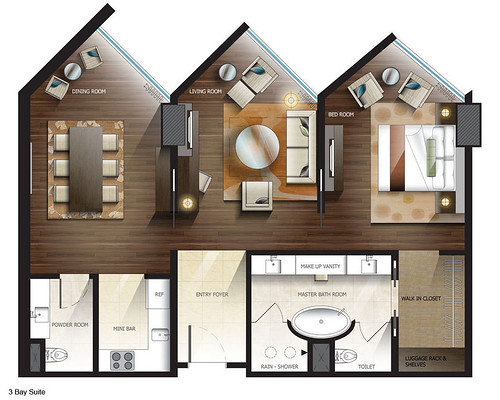
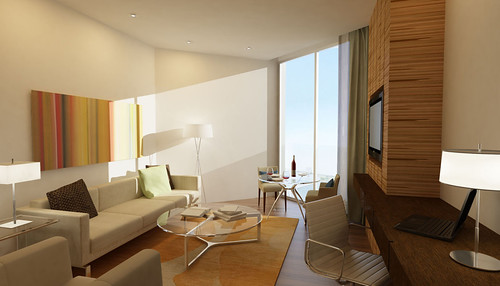


StarCity Nha Trang hotel is a fully serviced combination with conveniences and public services such as swimming pools for adults and children, conference room, bar/restaurant, spa and healthcare, bank, ect. Living in the condotel room, the owners escape from the city dust and noise to set free their spirit to the sea and also make profit from their assets by renting the condotel rooms during the time they do not use.
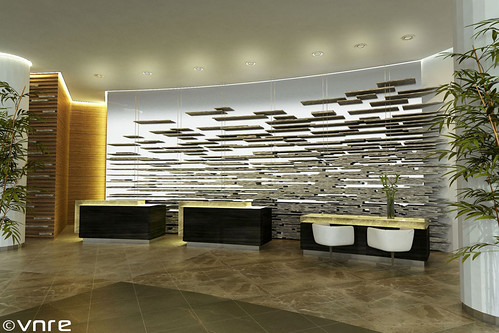





Development team
- Investor: Ocean Hospitality Hotel Development and Management, member of Ocean Group
- Architectural Design: 5G Studio Collabarative - USA
- Structural Design: Vietnam National Construction Consultants Corporation - VNCC
- M&E Design: Vietnam National Construction Consultants Corporation - VNCC
- Quality Management: Song Da Investment & Construction JSC
- Interior Design: 5G Studio Collabarative - USA
- Landscape Design: 5G Studio Collabarative - USA
- Contractor: Cotec Construction Joint Stock Company - CotecCons
The project was started construction on 23/03/2012, basement pakage is expected to be completed within five months of construction.
For further information, please contact:

Owning the most beautiful location in Nha Trang at the centre of Tran phu street and opposite to the sea, StarCity Nha Trang is a special gift for sea lovers who want to dip their lives into fresh nature. From the hotel, the condotel owners could easily access to famous spot such as Ponagar temple, Yanbay cascade, Long Son pagoda…
StarCity Nha Trang is a 21 storey – 4 star hotel built on area of 2.454 m2 with 217 hotel rooms and 92 condotel flats. The 2 foundation floors shall be service area of shopping, bar/restaurants, swimming pool, healthcare and spa, etc. Hotel rooms for tourists are arranged from 3th to 15th floor and condotel apartments are on 16th to 21th floors.
Condotel flat has moderate area from 33 to 99 m2, suitable with the invesment budget of the customer.
Interior




Facilities
StarCity Nha Trang hotel is a fully serviced combination with conveniences and public services such as swimming pools for adults and children, conference room, bar/restaurant, spa and healthcare, bank, ect. Living in the condotel room, the owners escape from the city dust and noise to set free their spirit to the sea and also make profit from their assets by renting the condotel rooms during the time they do not use.






Development team
- Investor: Ocean Hospitality Hotel Development and Management, member of Ocean Group
- Architectural Design: 5G Studio Collabarative - USA
- Structural Design: Vietnam National Construction Consultants Corporation - VNCC
- M&E Design: Vietnam National Construction Consultants Corporation - VNCC
- Quality Management: Song Da Investment & Construction JSC
- Interior Design: 5G Studio Collabarative - USA
- Landscape Design: 5G Studio Collabarative - USA
- Contractor: Cotec Construction Joint Stock Company - CotecCons
The project was started construction on 23/03/2012, basement pakage is expected to be completed within five months of construction.
For further information, please contact:
Ocean Hospitality Hotel Development and Management
Add: No 4 Lang Ha, Thanh Cong Ward, Ba Dinh District, Hanoi
Tel: 84.4.3772 7252 - Fax: 84.4.3772 7073
Email: info@och.vn
Google Account Video Purchases
Trần Quang Khải, Lộc Thọ, Nha Trang, Khánh Hòa, Việt Nam
27 thg 3, 2012
Investors seeking real estate from old projects
A lot of people are hunting the projects with the completion of ground clearance and houses on basis of competitive land price and construction cost.
Investors offloading the projects with uncompleted legislative procedures
Investing in real estate is always the purpose of many urban people because everyone thin that the investment will come to victory, never loss. So, not only those with abundant money but also the people with modest funding all have chosen specific segments to invest.
However, since the market became gloomy, the real estate price has fallen sharply, many investors had time to calm down and learn lessons for them.
Coming from the reality, prices of the projects with uncompleted procedures or ground clearance are slipping. Typically, the price of Thanh Ha-Cienco 5 project (Ha Dong Dist, Hanoi) plunged 40-45 million dong to 20-25 million dong per square meter, Kim Chung-Di Trach from 50-55 million to 25-30 million dong/sqm, An Thinh 6 project from 28 million to approximately 20 million dong/sqm.
Bich Lien, Director of Hanoi real estate trading floor said that in Ha Dong Dist, the project land prices saw a clear difference. While the prices of urban areas such as Van Khe, Van Phu, Xa La fell 7-10 million dong/sqm on average, that of the others like Thanh Ha dropped 20 million dong/sqm.
“Currently, the market is focusing on the completed projects and available delivery. And the projects with pending ground clearance are not attractive and almost unmoved for the last one year”, she added.
House buyers in the past recent really lost faith in real estate projects because there have been a lot of legislative conflicts between buyers and investors. So the market is shifting to the safe investment trend due to limited credit of banks and limited money source of buyers.
Opportunities from old projects
The market trend is offering good opportunities for completed projects.
Nguyet Nga, Director of Phat Loc Real Estate Company was quoted as saying that the property price is at low level therefore many customers decided to join the market at this time. The point is that customers are paying attention to completed projects only. A house in the projects in Ha Dong Dist costs around 7-8 billion dong per 80-90 square meter unit. But with only 4-5 billion dong, customers can afford to buy a house with completed body construction, which is attractive for long term investors and real demanders who do not have financial pressure. - Source: Vietbiz24
Investors offloading the projects with uncompleted legislative procedures
Investing in real estate is always the purpose of many urban people because everyone thin that the investment will come to victory, never loss. So, not only those with abundant money but also the people with modest funding all have chosen specific segments to invest.
However, since the market became gloomy, the real estate price has fallen sharply, many investors had time to calm down and learn lessons for them.
Coming from the reality, prices of the projects with uncompleted procedures or ground clearance are slipping. Typically, the price of Thanh Ha-Cienco 5 project (Ha Dong Dist, Hanoi) plunged 40-45 million dong to 20-25 million dong per square meter, Kim Chung-Di Trach from 50-55 million to 25-30 million dong/sqm, An Thinh 6 project from 28 million to approximately 20 million dong/sqm.
Bich Lien, Director of Hanoi real estate trading floor said that in Ha Dong Dist, the project land prices saw a clear difference. While the prices of urban areas such as Van Khe, Van Phu, Xa La fell 7-10 million dong/sqm on average, that of the others like Thanh Ha dropped 20 million dong/sqm.
“Currently, the market is focusing on the completed projects and available delivery. And the projects with pending ground clearance are not attractive and almost unmoved for the last one year”, she added.
House buyers in the past recent really lost faith in real estate projects because there have been a lot of legislative conflicts between buyers and investors. So the market is shifting to the safe investment trend due to limited credit of banks and limited money source of buyers.
Opportunities from old projects
The market trend is offering good opportunities for completed projects.
Nguyet Nga, Director of Phat Loc Real Estate Company was quoted as saying that the property price is at low level therefore many customers decided to join the market at this time. The point is that customers are paying attention to completed projects only. A house in the projects in Ha Dong Dist costs around 7-8 billion dong per 80-90 square meter unit. But with only 4-5 billion dong, customers can afford to buy a house with completed body construction, which is attractive for long term investors and real demanders who do not have financial pressure. - Source: Vietbiz24
Enterprises saying good bye to real estate business
Due to the prolonged difficulties on the property market, a lot of enterprises have to restructure their investment portfolio, seek way to transfer projects to other partners, and say goodbye to the real estate business.
Back to core capacity
Some years ago when the realty market was booming, many firms in many different industries sought ways to enter property investments and develop condominium projects. HoaSen Group also had the ambition to go beyond five major business sectors including steel, construction material, financial investment, seaport and logistics to invest in the property market.
The company kicked off the Pho Dong-HoaSen project in Phuoc Long B Ward, Dist 9, HCM City in late 2009 as a start of investment expansion strategy. It planned to supply around 200 condos to the market. This was the one of three projects HoaSen wanted to develop in Dist 9.
But after only two years of construction, HoaSen Group decided to transfer 50% to the joint venture partner Pho Dong Investment Development JSC due to unfavourable market conditions.
Also, HoaSenGorup is searching for a partner to sell HoaSen-Phuoc Long B condo project with 400 units in Dist 9. The project is capitalized at 520 billion dong. Till now the company has disbursed around 46 billion dong into the project.
Similarly, the group plans to transfer HoaSen Riverview condo project in Bung OngThoan, PhuHuu Ward, Dist 9. Of total estimate of 650 billion dong, the firm poured around 45.5 billion dong into the project.
Because of the difficult macro-economy, HoaSen Group had to re-estimate all investment projects to collect capital for developing core business of steel and plastic.
Its Chairman Le Phuoc Vu on March 22 admitted that economic upheavals and market changes were big lessons for the company so his firm will not expand to non-core business.
With the same move, Vietnam Oil and Gas Group (PetroVietnam) will stop investment in the complex of PetroVietnam Tower, 5-star hotel and entertainment park on 25 hectares in Me Tri Commune, TuLiemDist, Hanoi with a view to focus on core operations.
Earlier, on March 12, the Prime Minister requested PetroVietnam not to continue implementing property projects and to use all resources for main operations.
Focus to survive
While other firms are rushing to divest capital from the realty market, property developers are struggling with the market hardships. In order to manage capital, a lot of the developers are transferring projects and land.
At the shareholders meeting on March 20, Van Phat Hung Joint Stock Co has announced it would sell their land fund in Dist 2 and Dist 9, and a land lot for building its office in Dist 7 (HCM City) in its capital restructure strategy.
Along with the target of selling 70 condos in Lacasa project within this year, Van Phat Hung will offer 300 billion dong worth of convertible bonds to supplement its working capital for short term and long term plans.
Meanwhile, Pacific Property and Infrastructure Investment Joint Stock Company (PPI) are looking for investors for cooperation or transfer of two property projects in Thu DucDist, HCM City.
The company also is offering the price of 29 million dong per square meter for 2,400 sqm used to develop PPI Tower in HiepBinhChanh Ward and seeking a partner for Water Garden complex at 15 million dong per sqm.
2012 is seen as the year of Merger and Acquisitions (M&As) and the chance for rich financial investors.
Mr Pham Xuan Can, Chairman of Soho Vietnam, an expert in real estate marketing and transfer, said that the demand for realty project transfers is booming at this time. Many investors through the company are selling 80 projects.
“The property market is being restructured and in next 2-3 years, the market will have a new face”, he added. – Source: Vietbiz24
Back to core capacity
Some years ago when the realty market was booming, many firms in many different industries sought ways to enter property investments and develop condominium projects. HoaSen Group also had the ambition to go beyond five major business sectors including steel, construction material, financial investment, seaport and logistics to invest in the property market.
The company kicked off the Pho Dong-HoaSen project in Phuoc Long B Ward, Dist 9, HCM City in late 2009 as a start of investment expansion strategy. It planned to supply around 200 condos to the market. This was the one of three projects HoaSen wanted to develop in Dist 9.
But after only two years of construction, HoaSen Group decided to transfer 50% to the joint venture partner Pho Dong Investment Development JSC due to unfavourable market conditions.
Also, HoaSenGorup is searching for a partner to sell HoaSen-Phuoc Long B condo project with 400 units in Dist 9. The project is capitalized at 520 billion dong. Till now the company has disbursed around 46 billion dong into the project.
Similarly, the group plans to transfer HoaSen Riverview condo project in Bung OngThoan, PhuHuu Ward, Dist 9. Of total estimate of 650 billion dong, the firm poured around 45.5 billion dong into the project.
Because of the difficult macro-economy, HoaSen Group had to re-estimate all investment projects to collect capital for developing core business of steel and plastic.
Its Chairman Le Phuoc Vu on March 22 admitted that economic upheavals and market changes were big lessons for the company so his firm will not expand to non-core business.
With the same move, Vietnam Oil and Gas Group (PetroVietnam) will stop investment in the complex of PetroVietnam Tower, 5-star hotel and entertainment park on 25 hectares in Me Tri Commune, TuLiemDist, Hanoi with a view to focus on core operations.
Earlier, on March 12, the Prime Minister requested PetroVietnam not to continue implementing property projects and to use all resources for main operations.
Focus to survive
While other firms are rushing to divest capital from the realty market, property developers are struggling with the market hardships. In order to manage capital, a lot of the developers are transferring projects and land.
At the shareholders meeting on March 20, Van Phat Hung Joint Stock Co has announced it would sell their land fund in Dist 2 and Dist 9, and a land lot for building its office in Dist 7 (HCM City) in its capital restructure strategy.
Along with the target of selling 70 condos in Lacasa project within this year, Van Phat Hung will offer 300 billion dong worth of convertible bonds to supplement its working capital for short term and long term plans.
Meanwhile, Pacific Property and Infrastructure Investment Joint Stock Company (PPI) are looking for investors for cooperation or transfer of two property projects in Thu DucDist, HCM City.
The company also is offering the price of 29 million dong per square meter for 2,400 sqm used to develop PPI Tower in HiepBinhChanh Ward and seeking a partner for Water Garden complex at 15 million dong per sqm.
2012 is seen as the year of Merger and Acquisitions (M&As) and the chance for rich financial investors.
Mr Pham Xuan Can, Chairman of Soho Vietnam, an expert in real estate marketing and transfer, said that the demand for realty project transfers is booming at this time. Many investors through the company are selling 80 projects.
“The property market is being restructured and in next 2-3 years, the market will have a new face”, he added. – Source: Vietbiz24
How To Use The Telephone To Be A Relationship Builder
Every business leader should periodically call his/her company to observe how their customers are being treated by their employees -- because, all too often a phone conversation becomes a customer turnoff rather than a relationship builder.
So, here's a checklist that is primarily from sales expert and author Paul R. Timm that you can use to evaluate your organization's customer service via the phone:
1. Was the phone answered after two rings or less?
2. Did the employee use an appropriate greeting?
3. Did the employee identify himself or herself by name?
4. Was the employee's tone of voice pleasant and businesslike?
5. Was the call handled efficiently without being abrupt?
6. Did the employee provide accurate information or refer the caller to an appropriate person?
7. Did the employee reflect the best image for the company?
8. Did the employee thank the caller?
9. Did the employee make prudent use of putting the caller on hold if it was necessary to do so?
10. Did the employee use friendly and tactful words?
11. Did the employee accuse the customer of anything?
12. Did the employee fumble when transferring the call if making a transfer was necessary?
13. Was there distracting background noise on the employee's end during the call?
3 Things Every Mission Statement Must Have
A lot of companies struggle when creating their mission statement.
Author Peter F. Drucker provides the following good advice in one of my favorite book's of his, The Five Most Important Questions You Will Ever Ask About Your Organization:"
Every mission statement has to reflect three things:
- Opportunities
- Competence
- Commitment
- What is our purpose?
- Why do we do what we do?
- What, in the end, do we want to be remembered for?
Real Estate Market: Challenging Investor Confidence
VNRE - The freezing market has sent down real estate prices in Vietnam but investors do not feel the right time to invest in. According to Mr Stephen Wyatt, General Director of Knight Frank Vietnam, a property consulting company, investors never buy a product when the market is on the peak of a cycle. So, will real estate prices continue to fall more?
Heavy financial pressures
It is obvious that development potentials of the Vietnamese real estate market remain huge. Oddly enough, although the demand is very high, dozens of thousands of apartments are unsellable. This is because owners do not want to sell on expectation of higher prices while buyers want to wait for lower prices.
Indeed, this is possibly the best opportunity for long-waiting foreign investors to invest in. Currently, many foreign investors are ready to take over property projects invested by Vietnamese companies. At present, pressures are placed on the shoulder of domestic investors as they have to seek capital to ease financial strains.
Although prices have fallen to the lowest level in the past two years, it is hard to find a meeting point of buyers and sellers. The supply of well-located and affordable projects is thin, and vice versa.
Under this circumstance, both domestic and foreign investors prefer standing on the sideline and waiting for better policies. And, patience is seemingly rewarding when the State Bank of Vietnam (SBV) announced to cut ceiling deposit rates by 100 percentage points, laying the ground for the cut in lending rates. This is also the basis for many property experts to believe that the real estate market will recover towards the end of this year.
Medium and long-term opportunities
Remarking on the medium and long-term real estate market, Mr Stephen Wyatt said opportunities for investors are optimistically open. “We are seeing strong demand for many of the investments, land and developments sites that we are currently selling. With renewed optimism and a return of confidence, 2012 is the time to start looking at investing in Vietnam”.
The Vietnamese real estate market essentially enhances transparency and market laws to mitigate risks for domestic investors. The lack of transparency will lead to hearsay-based investment decisions.
Real estate companies, particularly small and medium ones, lack administrative systems, especially risk management. The lack of operating professionalism is a reason why they difficultly access capital sources and do not have the trust of customers. Thus, according to experts, real estate companies necessarily restructure to have healthy market development.
Mr Nguyen Huu Cuong, Chairman of Hanoi Real Estate Club, said: The property market will soon recover if the stock market gains stable growth and investor confidence as it is now.
He said the stock market and the property market always have close interactive relations. Positive development of the stock market will be clearly translated into the revitalisation of the real estate market. Thus, if the current growth of the stock market is maintained and continued, capital flows from this market will surely run into the property market.
However, it is extremely hard to identify what factors will determine the recovery of the real estate market. Real estate investing is typically driven by herd sentiment in Vietnam. Investors will jump into the market if they feel it is good enough but they will rush to exit if they lack confident. Hence, according to experts, the instability of the market is not over.
Reported by Luong Tuan | VCCI News
Google Account Video Purchases
Hanoi, Hoàn Kiếm, Hanoi, Vietnam
26 thg 3, 2012
5 Open-Ended Questions To Ask Your Customers
I really like author Paul R. Timm's advice to stop asking your customers the "typical" questions and instead ask them open-ended questions.
Here's what Timm recommends:
Don't Ask:
- How was everything?
- Can I get you something else?
- Did you find everything you need?
- Will that be all?
- Was everything satisfactory?
- What else can I do for you?
- What else can I get for you?
- What else can I help you with?
- What else could we do to better serve you?
- How else can we be of help?
25 thg 3, 2012
Golden knight rides to rescue
The mid-end sector is being touted as the latest saviour of Vietnam’s second home market.
Luxury properties have traditionally dominated Vietnam’s second home market, but developers are now looking to cash in on the demand for mid-end second homes.
This move is part of a general trend towards diversification in the second-home market in this country with developers driving their investment towards small- and medium-sized products.
These can be sold at affordable prices and meet the demand of various types of customers. This trend started at the end of last year when developers shifted their portfolios to mid-end second-homes in a bid to cope with the low transaction in all other segments. In the northern provinces, Archiland is selling second homes in areas around Hanoi. Until last year, the company focused on selling high-end second homes priced at VND15-18 billion ($717,000 to $861,000) per unit.
However, from April of this year, Archiland will start selling second-home villas at what it says “lowest prices” on the market. The company plans to sell 68 houses of Dien Vien Village, part of Zen Resort in Ba Vi district, 50 kilometres from Hanoi. The starting price tag will be VND850 million ($40,600) for a home with a total land area of 220 square metres. Nguyen Thanh Nam, general director of Archi Invest Joint Stock Company, said second homes on the city’s fringes had many advantages compared to those in other areas.
“Investing in second homes in the city’s outskirt areas is safe because the majority of those projects have red books which permit the users to use them for a long time,” Nam said. Nam added that more customers can afford mid-end second homes in such areas because they cost only a twentieth of equivalent homes in the city centre. Other benefits included convenient transportation, good services and good infrastructure.
Moreover, Nam said investing in second homes in the city’s outskirts also brought other benefits in terms of rental possibilities. For example, a VND5 billion ($230,000) villa in Nine Ivory project in Ba Vi district was guaranteed to bring a revenue of VND18 million ($861) per month from leasing to tourists.
And last but not least, mid-end second homes could still sell in a dormant real estate market because the majority of their owners were long term end-users, and not short-term speculators as was the case with many other projects.
Apart from Dien Vien Village, there are many other mid-end projects appearing in the north. Green Oasis Joint Stock Company has recently launched its Green Oasis Villas in the Luong Son district of Hoa Binh province. These turn-key units carry prices of VND1.5-2.5 billion per unit ($71,700-$119,600).
INT Group is selling the Dong Chanh Villas 3 project, also located in Luong Son district at VND820 million ($39,230) per land plot and VND1.45 billion (69,370) for an unfurnished villa.
In the south, Venesia land plots in Nha Trang city are also attracting customers because of reasonable prices. Cen Group chairman Nguyen Trung Vu said customers could buy a Venesia villa for VND7.5 million ($358) per square metre in the project, the master plan of which was designed by PTW. Customers only have to splash out VND570 million ($27,270) for a plot to build a townhouse or VND2 billion ($95,684) for a villa.
Many other mid-end second-home projects are well absorbed. According to the latest report by Archiland, mid-end projects such as Nine Ivory in Ba Vi district and Melody Villas in Hoa Binh province were seeing good sales. Twenty-four of the 27 villas in Nine Ivory’s first phase have already been sold, while the investor of Melody Villas has sold 42 of a total of 108 villas.
“With the real estate market trending down, we aim to focus on the end-users and increase services while strictly keeping construction to schedule,” Nam said. – Source: VIR
Luxury properties have traditionally dominated Vietnam’s second home market, but developers are now looking to cash in on the demand for mid-end second homes.
This move is part of a general trend towards diversification in the second-home market in this country with developers driving their investment towards small- and medium-sized products.
These can be sold at affordable prices and meet the demand of various types of customers. This trend started at the end of last year when developers shifted their portfolios to mid-end second-homes in a bid to cope with the low transaction in all other segments. In the northern provinces, Archiland is selling second homes in areas around Hanoi. Until last year, the company focused on selling high-end second homes priced at VND15-18 billion ($717,000 to $861,000) per unit.
However, from April of this year, Archiland will start selling second-home villas at what it says “lowest prices” on the market. The company plans to sell 68 houses of Dien Vien Village, part of Zen Resort in Ba Vi district, 50 kilometres from Hanoi. The starting price tag will be VND850 million ($40,600) for a home with a total land area of 220 square metres. Nguyen Thanh Nam, general director of Archi Invest Joint Stock Company, said second homes on the city’s fringes had many advantages compared to those in other areas.
“Investing in second homes in the city’s outskirt areas is safe because the majority of those projects have red books which permit the users to use them for a long time,” Nam said. Nam added that more customers can afford mid-end second homes in such areas because they cost only a twentieth of equivalent homes in the city centre. Other benefits included convenient transportation, good services and good infrastructure.
Moreover, Nam said investing in second homes in the city’s outskirts also brought other benefits in terms of rental possibilities. For example, a VND5 billion ($230,000) villa in Nine Ivory project in Ba Vi district was guaranteed to bring a revenue of VND18 million ($861) per month from leasing to tourists.
And last but not least, mid-end second homes could still sell in a dormant real estate market because the majority of their owners were long term end-users, and not short-term speculators as was the case with many other projects.
Apart from Dien Vien Village, there are many other mid-end projects appearing in the north. Green Oasis Joint Stock Company has recently launched its Green Oasis Villas in the Luong Son district of Hoa Binh province. These turn-key units carry prices of VND1.5-2.5 billion per unit ($71,700-$119,600).
INT Group is selling the Dong Chanh Villas 3 project, also located in Luong Son district at VND820 million ($39,230) per land plot and VND1.45 billion (69,370) for an unfurnished villa.
In the south, Venesia land plots in Nha Trang city are also attracting customers because of reasonable prices. Cen Group chairman Nguyen Trung Vu said customers could buy a Venesia villa for VND7.5 million ($358) per square metre in the project, the master plan of which was designed by PTW. Customers only have to splash out VND570 million ($27,270) for a plot to build a townhouse or VND2 billion ($95,684) for a villa.
Many other mid-end second-home projects are well absorbed. According to the latest report by Archiland, mid-end projects such as Nine Ivory in Ba Vi district and Melody Villas in Hoa Binh province were seeing good sales. Twenty-four of the 27 villas in Nine Ivory’s first phase have already been sold, while the investor of Melody Villas has sold 42 of a total of 108 villas.
“With the real estate market trending down, we aim to focus on the end-users and increase services while strictly keeping construction to schedule,” Nam said. – Source: VIR
Interest rate vs yield
Với các công cụ nợ ngắn hạn, người cho vay thường được hưởng lãi (interest) một lần. Tiền lãi có thể được trừ (chiết khấu) khỏi tổng số tiền cho vay tại thời điểm bắt đầu hoặc cộng thêm vào thời điểm kết thúc. Dù hình thức thanh toán thế nào đi nữa, tỷ lệ lãi suất (interest rate) trên tổng số tiền cho vay phải được thỏa thuận và cố định ở thời điểm công cụ nợ bắt đầu có hiệu lực.
Với trái phiếu, thường có thời hạn dài hơn hai năm, tiền lãi được trả định kỳ theo một tỷ lệ cố định thỏa thuận ở thời điểm phát hành(*). Số lãi này có thể trả hàng năm (như trái phiếu chính phủ Đức) hay hai lần một năm (trái phiếu chính phủ Mỹ, Anh, Nhật, Úc). Trong quá khứ trái phiếu thường được phát hành dưới dạng một tờ chứng chỉ đính kèm một số tem đúng bằng số lần trả lãi định kỳ. Mỗi lần chủ của tờ trái phiếu đến lĩnh tiền lãi, nhà phát hành sẽ cắt một tờ tem khỏi cuống trái phiếu để xác nhận đã thanh toán lần trả lãi đó. Trong tiếng Anh tờ tem này gọi là coupon nên mặc dù hiện giờ trái phiếu đã được điện tử hóa hoàn toàn người ta vẫn dùng thuật ngữ này để chỉ lãi (suất) định kỳ của một loại trái phiếu.
Vì trái phiếu có thể mua bán trên thị trường nên giá của nó thay đổi theo cung cầu hàng ngày chứ không nhất thiết bằng đúng với mệnh giá. Bởi vậy tỷ lệ sinh lợi của một loại trái phiếu cũng thay đổi chứ không cố định như lãi suất định kỳ (coupon) được ấn định ở thời điểm phát hành. Thực tế trong các giao dịch trên thị trường quốc tế người ta chỉ quan tâm đến giá chứ ít ai quan tâm đến lãi suất định kỳ. Tuy nhiên để tiện so sánh mức độ sinh lời của các loại trái phiếu có lãi suất định kỳ và thời gian đáo hạn khác nhau, người ta sử dụng một con số qui ước gọi là lợi suất (yield) cho mỗi loại trái phiếu.
Về mặt kỹ thuật lợi suất được tính bằng cách xác định tỷ lệ hoàn vốn nội tại (internal rate of return) của dòng tiền (cashflow) do trái phiếu đem lại. Lợi suất càng cao thì giá giao dịch trái phiếu càng rẻ, nghĩa là càng có lợi cho người mua trái phiếu hay người cho vay tiền. Nhưng việc lời lỗ trong kinh doanh trái phiếu trên thị trường thứ cấp không ảnh hưởng gì đến nhà phát hành trái phiếu. Dù lợi suất trái phiếu có tăng hay giảm thì người phát hành vẫn phải trả một khoản tiền lãi định kỳ cố định (coupon) vào một thời điểm nhất định trong năm cho đến khi đáo hạn.
Mặc dù báo chí và giới học thuật nhắc nhiều đến khái niệm lợi suất, cần lưu ý đây chỉ là một qui ước thị trường để tiện so sánh, khi mua bán trái phiếu người ta phải qui đổi ra giá giao dịch chứ không dùng lợi suất. Tuy nhiên giá mà các công ty chứng khoán chào hoặc được niêm yết trên các sàn giao dịch chưa phải là giá cuối cùng bên mua phải thanh toán. Giá niêm yết thường được gọi là giá sạch (clean price) nghĩa là giá chưa tính đến phần tiền lãi định kỳ tích lũy kể từ lần thanh toán gần nhất. Thị trường trái phiếu niêm yết giá sạch để tránh tình trạng giá bị giảm đột biến sau khi lãi
(Ghi chú: (*) có một số loại trái phiếu không cố định lãi suất định kỳ mà cho phép thay đổi tùy theo tình hình thị trường.)
M&A boom in southern markets

Ho Chi Minh is currently the hub for such deals. One of the first major deals was in 2011, when Singapore's Dancin Holdings bid for Tan Tao A urban area project, owned by Khang An Investment Real Estate JSC. It later was shored up when the property fund company JSM Indochina announced that they would transfer the land use rights of Peninsula project to Sao Sang Saigon JSC.
In 2012, the pace of M&A picked up in real estate market, when Capita Value Homes Company acquired 70 per cent stake in a high rise project from Khang Dien Saigon JSC, and also Hoang Anh Gia Lai buying 100 per cent another project in District no. 7
Many companies have decided to transfer their projects. Hoa Sen Group said it is considering transferring a series of its real estate projects, including Hoa Sen Phuoc Long and Hoa Sen Riverside Apartments, Hoa Sen - Gemadept Airport. A number of industrial zones or resort projects in Hoa Binh Corporation are also set for transfer.
Also, Dat Xanh Investment Corporation has made successful acquisitions of four property projects, including Majestic and Gold Hill projects in Dong Nai Province, the Bella in Ho Chi Minh City and the Marina in Binh Duong Province. Thien Minh Group also took over the Victoria Hotels property in Vietnam.
One of the biggest players in these deals has been the C.T Group. In March, the group announced its $24 million bid for South Korea's GS firm to develop golf projects in Cu Chi District, Ho Chi Minh City.
Previously, the acquisitions were often made by foreign companies, trend has been changing. Vietnamese firms have been making a series of large M&A deals.
A representative of the C.T Group said the deals are being made not only in the realty market but in other industries as well, with the busiest areas in Ho Chi Minh City and southern regions. - Source: VIR
24 thg 3, 2012
The Consumerization Of IT And It's Impact In The Workplace
By: Guest Author, Kyle Lagunas
Consumer technologies are infiltrating the workplace. Employees have access to powerful tools, applications and networks at home, and expect that same access at work.
From employee and manager self-service portals to the growing number of social media elements in performance and learning management, the technology employees expect to find in the workplace is changing.
- How will this shift--the consumerization of IT--impact the way an organization recruits, engages and manages its workforce?
Lagunas: There’s a lot of conversation around the need for HR to position itself as a more strategic and consultative, rather than administrative and transactional, function. How might consumerization help (or hurt) efforts to that end?
Kevin W. Grossman, Chief Strategy Officer at HRMarketer.com: To me it’s obvious it’ll help, if it’s executed efficiently and effectively. Improved technologies, predictive data analytics, autonomy, impulse control and self-management—all of this means less employee relations nightmares, less time spent micro-managing, and more time freed up to guide and grow the enterprise into the 21st century. To be able to identify what needs to get done where and why and by whom and how soon, and then actually do it with individuals and teams all over the world—that's how consumerization is helping today.
Lagunas: Many organizations struggle with the unique challenges specific to recruiting and managing an increasingly mobile and tech-savvy workforce. How can HR tackle these challenges head on, and support leadership in these endeavors?
Bob Calamai, Director of HRM & Development at NYU/SCPS: We've come a really long way—from command and control management where if a manager didn't see you in your cubicle you weren't working. We're moving more quickly toward a workforce that is more scattered, and there are some basic management principles that leaders need to keep in mind. What do employees want? Targets, feedback—what's expected and how they're doing. If we ask, “How can a remote workforce linked to technology impact those things—positively or negatively?” that will spark some interesting conversations with your leadership.
Lagunas: There’s a widely-held view that access to consumer technology (social media, the Internet, mobile apps) will offer too many distractions, and negatively impact productivity. Do you agree or disagree?
Brandy Fulton, Vice President of HR Operations at Citrix Systems, Inc: The Internet, email, social media, mobile apps--all of those things that potentially represent a distraction from business are also enablers of business. Where would marketing be without social media? Where would people who do research and development be without the Internet? You have to remember that employees love to be treated like adults. They want respect and trust and they want you to enable them to be successful. And if you’re giving them all of the tools to do their jobs, they’ll appreciate it.
About the Author: Kyle Lagunas is the HR Analyst at Software Advice—an online resource for buyers guides and comparisons of talent management and HRMS software. You can read Kyle's full roundtable discussion here.
The 12 Ways Marriott Practices Good Leadership And Customer Service
The next time you stay at a Marriott hotel look in the nightstand drawer for Marriott's booklet that highlights its milestones and tells the Marriott story.
In the booklet, you'll find the following 12 ways that Marriott practices good leadership AND customer service:
- Continually challenge your team to do better.
- Take good care of your employees, and they'll take good care of your customers, and the customers will come back.
- Celebrate your people's success, not your own.
- Know what you're good at and mine those competencies for all you're worth.
- Do it and do it now. Err on the side of taking action.
- Communicate. Listen to your customers, associates and competitors.
- See and be seen. Get out of your office, walk around, make yourself visible and accessible.
- Success is in the details.
- It's more important to hire people with the right qualities than with specific experience.
- Customer needs may vary, but their bias for quality never does.
- Eliminate the cause of a mistake. Don't just clean it up.
- View every problem as an opportunity to grow.
Kudos to Marriott.
Saigon at Seven AM
VNRE - When the morning dew still covered, the Saigonese has been starting their work on construction sites, on the cargo ships at the Sai Gon port... We were in Thu Thiem - the east bank of the Saigon River to take these photos at 7am.
View large sizes on Google+: https://plus.google.com/photos/111943333216473685555/albums/5723391545524968065
Nhãn:
ConstructionUpdates
Google Account Video Purchases
1 Lương Định Của, An Khánh, Quận 2, Hồ Chí Minh, Việt Nam
Đăng ký:
Bài đăng (Atom)









